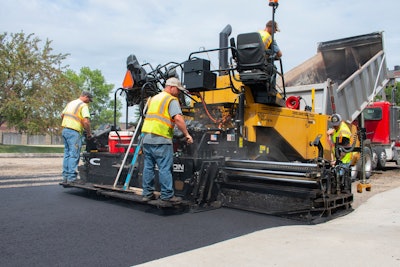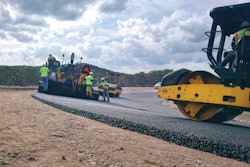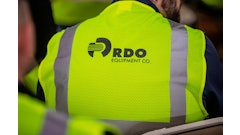
Paving contractors have a lot to worry about when laying asphalt. From the consistent deliver of the mix to the jobsite to the rollers obtaining density targets, there are many factors that can lead to disaster on your project. Between the mix and the roller is the all-important asphalt paver, the proper operation of which will mean the difference between success and failure. Here are the five main forces that you need to pay attention to, and keep consistent, in order to achieve a smooth ride.
1. Pull Force
The pull force of your paver is basically the paving speed. You want to make sure you maintain a constant speed while paving in order to keep the equilibrium between all forces impacting the mat. Dramatic changes in paving speed could result in a change in mat thickness which will lead to a rough ride.
Your paving speed should be calculated based on the material delivery schedule and the capability of your rollers to keep up.
2. Head of Material
Keeping a consistent head of material will also help ensure a smooth ride. If your head of material is too high, the screed rises due to the increased resistance. If your head of material is too low, the screed will settle from decreased resistance. This involves maintaining a minimum amount of HMA in the hopper, regulating HMA feed rate by controlling conveyor/auger speed and flow gate openings (if present), and maintaining a constant paving speed. As the next section will discuss, a fluctuating HMA head in front of the screed will affect the screed angle of attack and produce bumps and waves in the finished mat.
The hopper should also never be allowed to empty during paving. This results in the leftover cold, large aggregate in the hopper sliding onto the conveyor in a concentrated mass and then being placed on the mat without mixing with any hot or fine aggregate. This can produce aggregate segregation or temperature differentials, which will cause isolated low mat densities. If there are no material transport vehicles immediately available to refill the hopper it is better to stop the paving machine than to continue operating and empty the hopper.
3. Screed Weight
The heavier screed you have, the more stability. While this is not something that you can alter on the jobsite, it can mean your paver will be less reactive to any changes that may occur while paving.
4. Shear Force
The shear force is basically the angle of attack between the screed and the mat. The correct angle of attack combined with the proper vertical adjustment of your screed will equal a stable screed and a quality mat.
5. Reaction of Material
Different mixes will require a different force from your paver so it’s important that the mix, and the mix temperature, remain consistent. Everything from AC content to variations in gradation will impact the quality of the mat.
When these five forces are in balance, the screed is held to-grade with an equilibrium angle of attack. Any changes in these forces will disrupt the balance of the forces, resulting in roughness and mat blemish. Ensure the maximum stability of these five forces to optimize screed performance.















![Lee Boy Facility 2025 17 Use[16]](https://img.forconstructionpros.com/mindful/acbm/workspaces/default/uploads/2025/09/leeboy-facility-2025-17-use16.AbONDzEzbV.jpg?ar=16%3A9&auto=format%2Ccompress&fit=crop&h=135&q=70&w=240)




